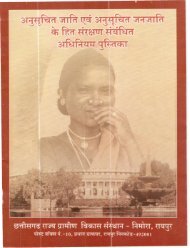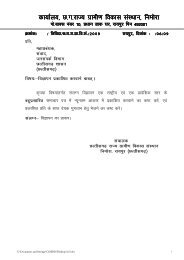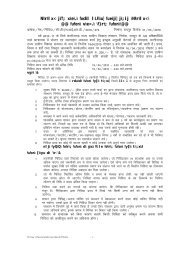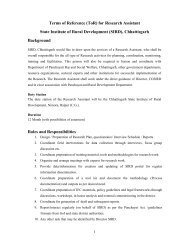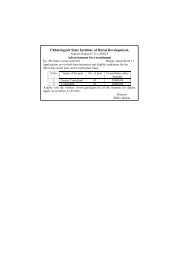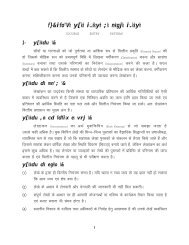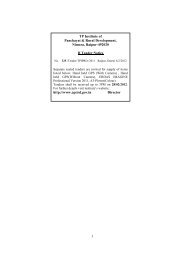Study on Mahua Sub Sector - Cgsird.gov.in
Study on Mahua Sub Sector - Cgsird.gov.in
Study on Mahua Sub Sector - Cgsird.gov.in
Create successful ePaper yourself
Turn your PDF publications into a flip-book with our unique Google optimized e-Paper software.
Van Dhan Samitis of Bastar<br />
Van Dhan Samitis are an <strong>in</strong>stituti<strong>on</strong>al arrangement created directly under the zilla<br />
panchayat <strong>in</strong> Bastar district with the purpose of collect<strong>in</strong>g forest produces from tribals<br />
and <strong>in</strong> the process stop exploitati<strong>on</strong> of tribals <strong>in</strong> the trade. It started with a campaign<br />
called Imli Andolan by the district adm<strong>in</strong>istrati<strong>on</strong> of the then Bastar district <strong>in</strong> Feb 1999.<br />
the then Collector of Bastar Mr Pravir Krishn was <strong>in</strong>strumental <strong>in</strong> c<strong>on</strong>ceiv<strong>in</strong>g and<br />
ground<strong>in</strong>g the <strong>in</strong>itiative. Self Help Groups were formed <strong>in</strong> villages through panchayats<br />
and entrusted the resp<strong>on</strong>sibilities of purchas<strong>in</strong>g m<strong>in</strong>or forest produces from villagers.<br />
TRIFED agreed to buy the forest produces so collected. A general manager level post<br />
was created so that quick decisi<strong>on</strong>s are taken <strong>in</strong> the highly volatile NTFP market. An<br />
SHG <strong>in</strong> Aasna village earned Rs 25,000 <strong>in</strong> just 15 days. After the success of SHGs, more<br />
groups were formed directly under the district panchayat, and these were called the Van<br />
Dhan Samitis (VDSs). TRIFED advanced funds to these samitis to purchase tamar<strong>in</strong>d<br />
from villagers and sell it to the federati<strong>on</strong>. The idea was to elim<strong>in</strong>ate the profiteer<strong>in</strong>g<br />
middlemen. The district adm<strong>in</strong>istrati<strong>on</strong> enforced the Krishi Upaj Mandi (Agricultural<br />
Produce Market<strong>in</strong>g) Act, which forbids traders from buy<strong>in</strong>g notified produces outside the<br />
market<strong>in</strong>g yards where the produce is aucti<strong>on</strong>ed. The SHGs m<strong>on</strong>opolized the weekly<br />
haats. After a first year, market reality struck <strong>in</strong> 2000-01. TRIFED had bought more than<br />
it could sell. Moreover purchase prices were set at a level much above the market prices.<br />
The traders bought tamar<strong>in</strong>d from neighbor<strong>in</strong>g Orissa and sold it at much cheaper rates.<br />
TRIFED could not sell and held <strong>on</strong> to the stock to get better prices and <strong>in</strong> the process lost<br />
huge m<strong>on</strong>ey. The scheme ended <strong>in</strong> May 2001. The scheme was heavily dependent <strong>on</strong> the<br />
support from district adm<strong>in</strong>istrati<strong>on</strong>.<br />
<strong>Mahua</strong> Banks<br />
The purpose of <strong>Mahua</strong> banks is to provide a cushi<strong>on</strong> aga<strong>in</strong>st the distress sale of <strong>Mahua</strong> by<br />
tribals. It purchases <strong>Mahua</strong> at the go<strong>in</strong>g rate or a notch above and sells it at less than the<br />
market price. The fee charged is called the storage fee. Five such Banks are operati<strong>on</strong>al<br />
now. The system <strong>in</strong>volves follow<strong>in</strong>g. Households sell their mahua <strong>in</strong> the bank. Price paid<br />
is two rupees higher from the market price and at the time of buy<strong>in</strong>g same mahua after a<br />
period of 4-5 m<strong>on</strong>ths the same mahua could be purchased at a rate which is three rupees<br />
less than market price. Also from the profit 3% is given to Village welfare fund for health<br />
related welfare activities. 150 HH are currently sell<strong>in</strong>g their <strong>Mahua</strong> <strong>in</strong> five banks. In<br />
2008-2009, mahua worth of Rs.60, 000 was purchased which was less than the previous<br />
year’s purchase of Rs.1, 07,000 as last year the crop of mahua was not so good due to<br />
unfavorable weather c<strong>on</strong>diti<strong>on</strong>s (ra<strong>in</strong>s not <strong>in</strong> time). The rates of these villages have been<br />
<strong>in</strong>fluenced by <strong>Mahua</strong> bank as the traders/middlemen have to raise their prices to purchase<br />
from these villages.<br />
Collective market<strong>in</strong>g<br />
Many NGOs adopt this approach. They facilitate aggregati<strong>on</strong> of produces at SHG and<br />
federati<strong>on</strong> level and then sell it to large traders. In the process the barga<strong>in</strong><strong>in</strong>g power of the<br />
primary producers are enhanced. This approach has been adopted for collective<br />
market<strong>in</strong>g of <strong>Mahua</strong> <strong>in</strong> Western Orissa Rural Livelihood Project and Jharkhand Tribal<br />
Development Project. In WORLP, dry<strong>in</strong>g platforms have been c<strong>on</strong>structed so that <strong>Mahua</strong>


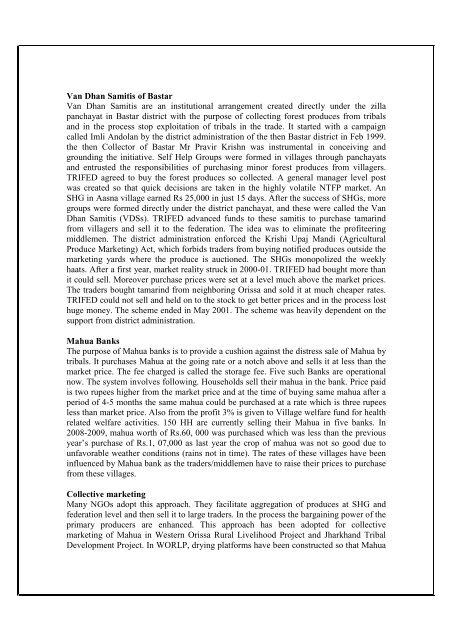
![kjsyky iapk;r ,oa xzkeh.k fodkl laLFkku]fueksjk] jk;iqj - Cgsird.gov.in](https://img.yumpu.com/43287415/1/184x260/kjsyky-iapkr-oa-xzkehk-fodkl-lalfkkufueksjk-jkiqj-cgsirdgovin.jpg?quality=85)
